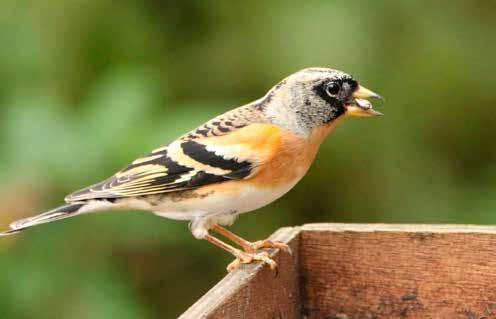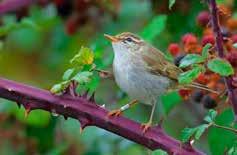
32 minute read
Autumn bird review ........................................................................Eddie Marsh
Autumn Bird Review
September 2016
Weather report: September was a dry month with twenty days with no rain; of the ten days when rain did fall the heaviest was 25mm on the 16th and the minimum rainfall was 1mm on both the 5th and 11th . High temperatures got up to 30º on the 13th and 15th followed closely by 29º on the 14th. The lowest night-time temperature was a surprising 6º on the 23rd, otherwise generally remaining in double figures. It was a good month, with daytime and nighttime temperatures above average for September. Spoonbill sightings continued throughout the county during the month, with a bit of dispersal. In detail, two at Levington on the 2nd, 3rd, 5th, 6th, 9th, 10th and 14th, Trimley on the 4th, 8th, 13th, 16th, 18th and 20th one juvenile. At Hazelwood there were 23 on the 2nd, two on the 9th and 11th, one on the 15th , three on the 18th and two again on the 29th, with two at Havergate on the 15th, three at Bawdsey going north on the 17th and 25 at Orfordness seen, coincidentally, on the 25th. Great White Egret made a comeback after a very poor August, reported throughout the county during the month, but mainly at the usual coastal sites as in previous months earlier this year. There was a bit of Dark-bellied Brent movement on the 27th with 800+ passing LBO. Garganey were still being seen during the month from Covehithe Broad, Minsmere, Hollesley and Trimley Nature Reserve – not so easy to find in eclipse plumage. A Goosander was over Pakefield Beach on the 11th . The only sightings of Wood Sandpipers came first from Carlton Marshes with one on the 7th and then Minsmere with one on the 15th and two reported on the 16th . Spotted Redshank numbers decreased during the month with 35 being reported throughout the county; highest counts were 14 from Minsmere on the 1st and the same again on the 16th. Not many reports of common waders: 300 Dunlin on Havergate on the 4th; three Ruff on the Blyth Estuary on the 9th and Little Ringed Plover sightings only from Hollesley RSPB Reserve, namely one on the 3rd, two on the 12th and two on the 13th . A few Caspian Gulls were seen during the month with most reports from Southwold/ Walberswick. During the month Little Gull sightings included 12 at Sizewell on the 2nd , three on the 3rd and nine on the 15th, three at Southwold on the 3rd, 18 at Thorpeness on the 6th, 26 on the 7th and 30 on the 9th. An adult Yellow-legged Gull was seen at Levington Creek on the 10th. A poor month for Arctic Terns, the only sightings being a juvenile on the 3rd and 5th at Southwold and one at Bawdsey on the 17th. The only sightings of Black Tern came from one past LBO on the 1st and one at Thorpeness on the 7th . There was good movement of common migrants throughout the county during the month with too many species and locations to mention in great detail. A Nightjar was trapped and ringed in a private garden in Hollesley on the 3rd. A Ring Ousel was at Bawdsey Lagoons on the 24th and one on the Alde Estuary on the 25th. Excellent numbers of Whinchat at coastal sites with 75+ being reported to BINS during the month, highest counts being 10 at Southwold on the 5th , six at Bawdsey Cliff on the 7th, seven in the Lowestoft area on the 7th, seven at Aldeburgh Marshes on the 11th and six at Orfordness on the 25th. Fewer Wheatear were reported during this month. A trickle of Redstart appeared throughout the month, plus a few Black Redstart in the later part of the month. Other common warblers including Whitethroat, Lesser Whitethroat, Garden Warbler, Blackcap, Reed Warbler, Sedge Warbler, Willow Warbler and Chiffchaff passed through, although these didn’t make
the BINS hotline. LBO recorded Firecrest on the 23rd, 27th and 28th. Fourteen reports of Pied Flycatcher came from coastal sites. Spotted Flycatcher were very scarce with the only report coming from LBO on the 23rd . Tree Pipits – a rare bird these days – were seen at Bawdsey with three on the 17th and two on the 18th. Even rarer, a Turtle Dove was seen on the approach road to Levington Marina on the 18th – one of worryingly few these days, where a few years ago these beautiful birds were a common sight. Finally, a Hobby was seen at Trimley Marshes on the 30th . Scarcer and Rare Sightings:
At Trimley SWT Reserve a Black-necked Grebe was found on the 24th and was reported there again on the 26th, 27th and 30th. One was also seen on the 25th from Stutton Ness. At Minsmere Sluice, a Shag was reported on the 5th and seen again on the 6th. A White Stork was seen at Crest Hill Fressingfield in a ploughed field on the 12th . There was a Pale-bellied Brent Goose at Trimley Nature Reserve on the 10th, 12th and 13th. On the 29th a Scaup was reported going north at 3.15pm at Minsmere. A few Honey Buzzards were seen passing through: one SW over Brantham at 10.20am on the 9th; one in the Lowestoft area flying over the Somerleyton Estate at 12.30pm on the 10th; a juvenile over Easton Bavents at 9.10am on the 13th; a Dark Phase juvenile south at Southwold on the 18th and a late Dark Phase juvenile south over the Aldeburgh Road on the 28th. September continued from August to be a fantastic month in Suffolk for Ospreys, with the Blyth Estuary excelling, Sighting details included: one on the 2nd, 9th , 12th, 13th, 14th, 15th and 25th and three on the 3rd, 4th, 5th, 7th, 8th and 10th. An amazing day was the 6th with four recorded, seen from various locations from the White Horse PH (honest!), Tinkers Marsh and Hen Reed Beds. One was reported circling over Alan Road in Ipswich on the 1st and one south over LBO on the 1st. Minsmere saw one over the levels on the 1st and then one was again reported on the 4th. One was seen south on the 2nd at Southwold Harbour south with two then seen on the 11th. At Stowmarket one flew over on the 8th and at Lakenheath one showed well on the 13th. Singles flew over the Stour Estuary at Cattawade on the 14th, Bawdsey Cliff south on the 16th; and the Hen Reed Beds on the 17th with the last one reported for September over Dunwich on the 23rd . September seawatching produced the following seabirds: Balearic Shearwater – two in Southwold on the 5th and singles at Thorpeness on the 12th and Lowestoft on the 17th and 18th. A single Manx Shearwater was seen at Thorpeness on the 7th and Minsmere on the 24th . Sooty Shearwater sightings included Southwold on the 3rd , 5th 6th, 25th and 29th; three at Lowestoft on the 5th; singles at Thorpeness on the 17th and 18th, LBO on the 27th, and Bawdsey on the 18th and 30th. There were sightings of Arctic Skua – two at Southwold on the 3rd and three on the 5th with nine at Lowestoft on the 5th. At Sizewell there was one on the 15th and then three at Bawdsey on the 17th . Long-tailed Skua sightings were one juvenile at Southwold on the 5th and another juvenile on the 6th; at Lowestoft a single juvenile on the 5th, and two on the 6th. At Thorpeness there was one juvenile on the 7th and two on the 17th. Only two Bonxies were seen at Southwold on the 5th. A Leach’s Petrel was seen at Minsmere on the 24th and 25th. A rare sighting for Suffolk was a Puffin seen off Lowestoft on the 18th . It was a very quiet month in Suffolk for rare waders with only two American species report to BINS during September. A brief bit of excitement happened on the 12th at LBO when a rare wader in the form of a Buffbreasted Sandpiper made a very fleeting touchdown onto the Landguard Common. Luckily someone just had time to get a digiscope shot before it got up and headed south. What a shame that this good looking American Wader could not have hung around
for a couple of hours or so! Only two sightings of Pectoral Sandpiper this month, both from Minsmere: one very brief at 7.55am on the 17th on West Scrape before it flew off high to the south, then one on the scrape daily from the 28th-30th. Despite the general quiet, it was a cracking month for Curlew Sandpiper with at least 130 reports to BINS, the highest counts being: 29 at Havergate on the 4th , seven at Breydon Water on the 6th, seven at Hollesley RSPB Reserve on the 10th and 11th and nine at Trimley SWT Reserve on the 27th. There were sightings the whole month, mainly from the coast, with four reported on the 8th at Micklemere. It was also a very good month for Little Stint with 34 sightings from the 1st to the 22nd . Highest counts at Minsmere were nine on the 4th, three on the 15th, two on the 19th and one on the 22nd. Three were seen at Hollesley RSPB Reserve on the 1st, same again on the 3rd and 5th, three at Trimley SWT Reserve on the 2nd, two on the 4th and one on the 5th . At Corton old sewage works the Wryneck continued into September, showing on the 1st, 5th, 6th and 17th but there was no sign of this elusive and long-staying bird after this date. On the 4th an individual was reported on the grassy bank between car park and entrance of Heath Road Hospital and at Hollesley a single was trapped and ringed in a private garden on the 6th. One was at Kessingland sewage works on the 6th and at Trimley Nature Reserve one was seen at early evening near the visitor centre on the 7th. At LBO one was found on Icky Ridge on the 12th and at Hollesley RSPB Reserve on the 13th and 14th, a very obliging bird was found by John Richardson. At LBO one was found by the cottage garden mid-morning on the 24th. LBO also produced a nice White Wagtail on the 22nd . Furthermore, LBO had a nice surprise on the 20th when an Arctic Warbler was found in a net in the compound; the bird was also seen again on the 21st but remained very elusive! Also there on the 20th, a Barred Warbler was very briefly seen on the common. At Hollesley on the 7th, a Blyth’s Reed Warbler was trapped and ringed in a private garden (subject to acceptance). An elusive Icterine Warbler found by Dave Thurlow made a brief showing early morning near the allotments at Thorpeness on the 12th, but despite a lot of searching was not seen again. Another Icky was found on the disused railway track at Gunton on the 17th . A nice flurry of Yellow-browed Warblers occurred, the first being on the 18th at Corton allotments, the second at LBO on the 19th, one at Thorpeness on the 19th, with the 20th producing one at Worthing Road in Lowestoft and one at Bawdsey Manor, one trapped and ringed at Bawdsey Hall. The last reported sighting for the month was one found behind Zak’s Cafe, South Beach, Lowestoft on the 23rd. Always a great autumn treat to see these eastern gems. The managed retreat at Trimley produced a Red-backed Shrike on the 7th . Ravens made an appearance again this autumn with one on the 18th, two on the 20th and one on the 23rd at Cavenham Heath. A further single was seen circling over Hollesley Prison Café on the 26th, being mobbed by corvids. At Bawdsey Cliff, a Serin was reported south on the 18th. LBO had three Tree Sparrows arrive on the 22nd; these remained at least until the 29th. A sprinkling of Lapland Buntings, with sightings from Minsmere on the 15th , one or more at Hollesley RSPB Reserve on the 21st, one at Easton Bavants on the 21st , one at LBO on the 21st and finally one at Sizewell on the 27th . Arctic Warbler
Weather report: October was a dry month on the whole with 10 totally dry days and another 13 days with 2mm or less rain. Significant rainfall between 4mm and 7mm occurred on seven days. The highest temperature was 18º recorded on the 3rd and the high average for the the month was 15º. The lowest temperature was 3º on the the 11th and the low average for the month was 7º, making October was a mild month overall. Spoonbill sightings still continued throughout the county during the month from sites mentioned in previous roundups as well as an interesting sighting from the River Deben on the 1st where 14 were seen between Bawdsey and Ramsholt.
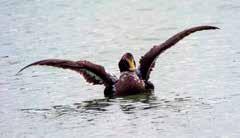
Sightings of Great White Egret were again reported throughout the county and some winter wild birds began arriving, with Great Northern Diver was seen off LBO on the 13th. At Minsmere, Bewick’s Swans were seen flying towards Island Mere on the 26th . Garganey were still being seen during the month from Covehithe Broad and Trimley Nature Reserve with a late record from Micklemere on the 31st. A Red-crested Pochard was reported from Pipps Ford on the 1st. From Stutton Ness a Greater Scaup was seen on the 27th and 28th and two more from Benacre on the 28th. A Velvet Scoter passed Bawdsey on the 13th, then on the 19th another was seen from LBO and one reported from Lowestoft, along with 12 Eider again from Lowestoft on the 20th. From Covehithe on the 4th White-fronted Geese were seen starting to arrive from the 14th with four going south at Westleton and then 37 south at Bawdsey on the 14th. At North Warren, 110 were counted on the 14th, 25 on the 15th and 30 on the 21st. Trimley SWT Reserve recorded 22 on the 29th and four at Livermore on the 30th. At North Warren there were 11 Tundra Bean Geese on the 14th, then four at Havergate on the 20th. At Minsmere on the 21st, 20 Pinkfooted Geese were seen offshore.
Photo: Phil Whittaker Great White Egret There were very few reported wader sightings this month: the Pectoral Sandpiper continued at Minsmere till the 5th, the rush of Curlew Sandpiper has passed, with just four at Trimley SWT Reserve on the 1st; 11 Spotted Redshank were reported from Minsmere on the 1st and then Little Stint from the 18th to the 30th. A Purple Sandpiper was seen at LBO on the 12th and reported on and off up to the 28th. There were three Jack Snipe at Pipps Ford on the 8th, one at Minsmere on the 15th and two at Trimley on the 29th . Caspian Gulls were still being reported during the month and as usual most reports were from Southwold/Walberswick along with Yellow-legged Gulls. A few Little Gulls still lingered with three at Gunton on the 19th and four at Southwold on the 20th and 21st . Another winter visitor was a Water Pipit seen at Minsmere on the 22nd, this followed by a Tree Pipit at LBO on the 11th. Only two Whinchat sightings, both at Walberswick near the Bailey bridge on the 1st. Just one Wheatear
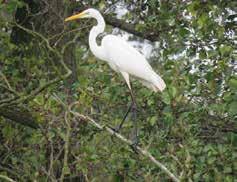
sighting during the month, at Hollesley on the 31st. A few Black Redstarts sightings: two at LBO on the 21st, one at Boyton on the 23rd and one at Kessingland on the 28th. There were 17 Firecrest sightings between the 5th and the 30th at various sites including Bawdsey, Minsmere, LBO, Southwold and Corton Churchyard. At Minsmere a late Common Redstart was sighted on the 28th. The only Pied Flycatchers seen were at Lowestoft on the 1st and Southwold campsite on the 3rd . Scarcer and Rarer Sightings:
A Black-throated Diver was seen offshore at LBO on the 8th. At Trimley SWT Reserve the Black-necked Grebe continued and was reported again on the 1st and 2nd and two were reported from Stutton Ness on the 16th and 19th. On the 4th, one was seen flying north from LBO. There were seveal sightings of Slavonian Grebe during the month, one from Lake Lothing showing well on the 4th, one on Mutford Lock, Lowestoft on the 7th, 9th and 11th and one from Stutton Ness on the 31st. At Dunwich, a Cattle Egret was reported on the 30th. A single late Honey Buzzard was sighted east over North Gree, Stoven at 1pm on the 22nd. Hazelwood Marsh produced an Osprey on the 1st, the only sighting for October. A Rough-legged Buzzard was seen on the 9th over south levels at Minsmere and another, probably the same bird over Westleton Heath at 3.30pm on the 10th. A Hobby flew over Bawdsey on the 8th . Short-eared Owls started to arrive with sightings from Lowestoft to Landguard during the month, the highest count being at Shingle Street on the 27th . October sea watching produced the following seabirds: one Leach’s Petrel past LBO on the 4th, one off Minsmere also on the 4th and one from Bawdsey on the 13th; two Balearic Shearwater past Bawdsey on the 4th and one off Minsmere on the 12th . Sooty Shearwater sightings included one from Covehithe on the 4th, two past Southwold on the 13th and one at Lowestoft on the 20th . One Long-tailed Skua was sighted off Bawdsey on the 4th and 10th . Arctic Skua sightings were two past Lowestoft on the 20th and one at Southwold on the 21st. At LBO, three Pomarine Skuas passed on the 4th , two were seen off Thorpeness on the 5th and one from Southwold on the 20th. Regarding Bonxies there were two off Southwold on the 19th, one on the 21st and two from Gunton on the 19th. A Black Guillemot was reported off Gorleston on the 19th. At Southwold on the 20th, two Little Auks were seen on the 20th and one at Dunwich on the 22nd . Little Auk
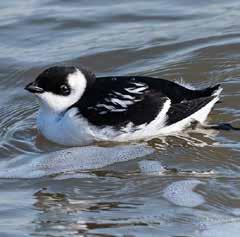
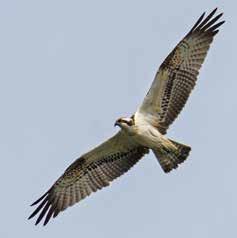
Osprey
Waxwing
On the 27th BINS got a late evening report of a Hoopoe being seen on the footpath to the hide at Hazelwood Marshes. It was located there again on the 28th where it remained until at least the 30th. Good to see some Shorelarks arriving – once a common winter visitor to Suffolk although not in recent years. Sightings occurred at Carlton Scrape, Minsmere, Lowestoft, Kessingland and Dunwich with a showy one at LBO from at least 20th to 23rd .
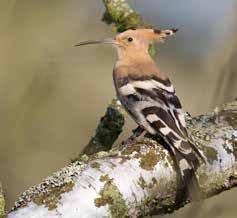
On the 20th a Dipper species was reported on a stream at Hawkes Mill in Needham Market at 3pm but in fading light the ID was not confirmed. Luckily it was still there the next day and confirmed as 1st winter Blackbellied Dipper. It showed well in the river opposite the Mill on and off during the next few days and also favoured other tributaries nearby, being often seen at three different weirs located along the river footpath behind the Mill. It remained till the month’s end, although some days being very elusive and odd days not being located.
It is always a great joy when Waxwings arrive to brighten up our winter months. Singles were sighted from 23rd at Boyton, Lowestoft area, Leiston and Dunwich. Hopefully this will be a good year for Waxwings with good numbers being reported arriving in the UK already.
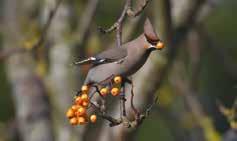
A Siberian Stonechat (Probably Stejneger’s Stonechat) was trapped, ringed and released at LBO on the 7th and it remained till the 8th but was often mobile – this will be another Suffolk first if DNA confirms this race and it is a potential split! What a great month for Ring Ousels with 80+ reported sightings, high counts of 16+ from the Bawdsey area on the 6th and 16 on the 8th , plus good numbers at Hollesley area on the
Black-bellied Dipper Siberean Stonechat
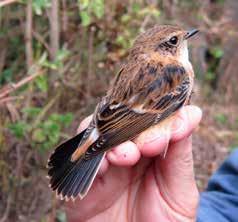
Photo: Ben Moyes Photo: Will Brame
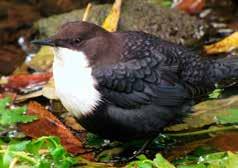
6th, LBO 8th and 9th, Peewit Hill same dates, and Minsmere on the 15th. At LBO on the 6th a Radde’s Warbler was reported in but no sighting reported after a lot of searching all day. On the 9th, a Lesser Whitethroat (probably Blythi Race) was reported at East Lane on the 9th with another at LBO from the 15th - 19th at least. A nice Blyth’s Reed Warbler was trapped and ringed at LBO on the 10th – a couple of Suffolk’s bigger county listers were grateful to catch this one at last! Unfortunately it disappeared from brambles on the common at 10.30am and no further sightings were made. Late autumn is the time for Dusky Warbler, and sure enough there was one at Corton Old Sewage Works on the 14th, then possibly three on the 15th; one remained at the Works, one was seen nearby along the disused railway track and one along Flycatcher Alley. Then another arrived at Warren Lane, Gorleston and showed well on and off from the 26th - 28th . Sightings of Yellow-browed Warblers continued into October from the north to the south of the county, with far too many sightings to list, however there was a massive count of 10 in the Lowestoft area on the 9th and again on the 10th, numbers dropping to two the next day and then two to three on and off until the 22nd. There were four excellent inland records: Great Livermore on the 2nd , Cavenham Heath on the 15th, Long Melford on the 17th and Great Cornard Mere SWT on the 22nd and 23rd. The last YBW reported for the month to BINS was a single from that stronghold of sightings, the Lowestoft area, Gunton Woods, on the 26th and Aldeburgh Town Marshes. It must be one of the best years in recent times for this fantastic little bird from Asia with BINS receiving 80+ sightings during the month. Another amazing gem from the east that we wait in hope for during October/November is the amazing tiny Pallas’s Warbler and they never disappoint when they arrive. This year, the first one was found on the 9th by Mark Cornish at East Lane, Bawdsey, where it showed well all afternoon to the delight of many Suffolk birders. One was then seen at Lowestoft Corton area on the 15th, and more sightings of mainly singles at Link Hill, Orfordness, LBO and Havergate with one finally ringed in a private garden in Hollesley on the 29th. With up to 12+ sightings reported into BINS I am sure most of the county caught up with one of these cracking gems. Possibly the only reported Red-backed Shrike this autumn was found at Westleton Heath on the 11th. It was a long stayer and was last reported on the 23rd. On the other hand, Great Grey Shrikes put on a good showing with singles at Covehithe on the 4th, LBO on the 7th, Lowestoft on the 8th and 17th, Eastbridge on the 14th, Southwold on the 20th and two at Dunwich on the 21st. Then a real long-staying bird was again at Westleton Heath from the 12th to the 23rd at least. A Raven again made an appearance on the 31st over Hollesley Prison. The Twite returned to Dunwich Shore Pools with a highest count of 62 being seen on the 23rd . On the 9th, two nice Mealy Redpolls were seen at Gunton and five seen briefly by the sluice cottage before flying north on the 15th . Pallas’s Warbler
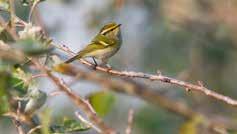
Mealy Redpoll
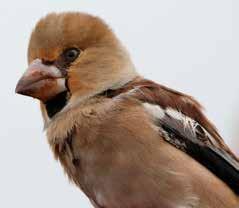
Hawfinch Nice to have some Hawfinches reported in, with a single sighted from LBO on the 7th, two at Lowestoft, Furze Wood on the 15th and one over Sizewell Hall on the 22nd . An immature Common Rosefinch was seen in fallow arable field / hedge off Keen’s Lane at Reydon on the 8th although distant. A little flurry of Snow Bunting occurred at the end of the month with two at LBO, two at East Lane and three at Dunwich on the 30th and three again flying over North Warren on the 31st. There was still a scattering of Lapland Buntings with up to 14 reports, the highest of three coming from Dunwich on the 30th and then two from Hollesley on the 31st, with singles being seen regularly amongst the Twite flock at Dunwich shore pools.
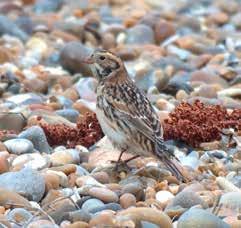
Lapwing Bunting
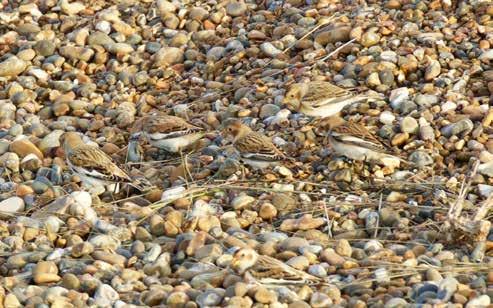
Snow Buntings
Weather report: November was again a fairly dry month with a total of 11 dry days and 8 days with 2mm or less rain. Significant rainfall of over 5mm fell on five days, with 29mm recorded on the 20th. Only 8 days reached above 10º, with the highest of 14º recorded on the 15th, whilst a low of -4 was recorded on the 30th with six nights at zero or below. The averages were normal for November.
The Mega button was pushed again in Suffolk, at Minsmere on the 4th, when an American Cliff Swallow was finally clinched around 2.30pm – another first for Suffolk. On what was until then a dull day, Steve Piotrowski and the D’Weasel (Eric Patrick) found a Hirundine sporting a whitish rump and squarish tail associating with Barn Swallows between the North Wall and the Visitor Centre. The bird was often distant, and in bad light getting good views was difficult, but eventually, when closer and better views were obtained by Steve and Eric as well as Richard Drew and Paul Green, the bird was confirmed as a firstwinter Cliff Swallow. It showed well around the visitor car park till 4.10pm, when it flew off with Barn Swallows to roost, probably in the reedbed in front of Bittern Hide. Being so late in the day, only a handful of Suffolk birders who happened to be at Minsmere or who lived very locally connected with this great find. Most of the County were nervously hoping that it would roost and then perform the next day and after a lot of chatting that evening amongst the Suffolk birding fraternity, a plan was put in place for those that had a high Suffolk List, namely to be at Minsmere before first light and plant themselves on the path between West and South Hides so the reedbeds towards Bittern Hide could be scanned in detail. On the morning of the 5th, a large number of Suffolk Listers and Twitchers from around the country were in position in the dark, but as the light grew no swallow activity was happening. Then, just after 7am, news filtered through to birders scanning the reeds that the Cliff Swallow was showing well around the visitor car park with six or seven Barn Swallows, creating a sudden it was a mass exodus to the car park. The Cliff Swallow was showing well here, but also ranging as far as the North Wall. After a while it started to perch with the swallows in various bushes near the North Wall giving excellent views to all the early birders and to birders who were now arriving continuously. Discussions led to the assumption that the birds must have roosted in the North Marsh reedbeds. As the sun got up and the temperature rose, the Cliff Swallow and Barn Swallows started ranging from the field behind the Visitor Centre to the Dunwich coastguard cottages and cliff, where it remained all day and showed well on and off till dusk when presumably it went to roost. On Sunday 6th, the Cliff Swallow was seen at 7.15am for just a few minutes before it flew off south with Barn Swallows and was not seen again, despite lots of people searching Minsmere all day. I am sure there were a lot of disappointed people who could not make it on Saturday and dipped the great bird on Sunday. Well done to Steve and Eric on a magnificent find and thanks for making happy bunnies out of lots of birders. Also on
Cliff Swallow
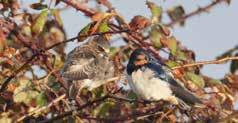
Cliff Swallow pictured with a Barn Swallow

behalf of all the birders both visiting and local I would like to give special thanks to Adam Rowlands and his staff at RSPB Minsmere for accommodating the vast numbers and allowing access to areas of the reserve that are normally out of bounds. Yet another Mega alert for Suffolk occurred early afternoon on the 19th: a Forster’s Tern had been found at Mistley – another first for Suffolk. You may be thinking that Mistley is in Essex and you would be correct. However, the Essex/Suffolk boundary at Mistley Quay runs through the middle of the channel, making it an easy matter to see when the Tern was in Suffolk. Once it left there and was at the Walls, it could not be counted. The Tern remained until dusk and was present again on the 20th, ranging more and spending long periods east of the quay. The Tern was not seen in the Mistley area all day on the 21st , but there was a report of it in the Dock Basin at Felixstowe where it was distantly observed from Shotley Marina. Coincidentally, around 3pm, Steve Piotrowski was around the Felixstowe Ferry area looking for Merlin for his year list battle with Eric (D’Weasel), when, stumbling upon a few Black-headed Gulls roosting on the salt marsh, he scoped them to check numbers for his Birdtrack records and – to his amazement – the Forster’s Tern was roosting with them! He raced the news out and a few local birders managed to get there before the light had gone, Will Brame getting a good digiscope shot. I expect Steve thought all his Christmases had come at once, with Cliff Swallow a n d Forster’s Tern both in the same month!
Another extremely rare bird for Suffolk was a Little Bunting flushed by Mark Cornish from the weedy field by the MOD compound at Bawdsey on the 13th. It was very elusive and last seen at 11.30am perched in hedgerow before flying north; only a handful of birders having connected. Luckily for Mark, others saw it and Ollie Slessor managed to get digiscope shot. It was flushed again on the 14th by one birder (Steve Abbott) and heard calling as it flew across the road. This was the last sighting, although the bird may have been present for over week –I personally had had a small bird go through the fence at the nearby plantation, and my gut instinct, having seen several on Shetland late September and early October, was that it was Little Bunting. Sea Duck Bonanza: Suffolk had its second biggest ever Sea Duck assembly since 1955. Back then, 5,000 were off Hopton and since then no other flock over 2,000 has been seen until now. The beginning of this massive gathering of Common Scoter in the bay off Dunwich started on the 15th with a count of 500 birds; by the 23rd it had increased to 1,200; on the 25th BINS had a count reported of 4,000 but this did not represent other counts of 2,500 on the 29th and 2,800 on the 30th. It has been an amazing sight to witness and it has been well worth the effort to see this spectacle. Adding to the excitement, this flock entertained good numbers of Velvet Scoter with 24 on the 19th, 43 on the 26th (highest count), 15 on the 28th, 33 on the 29th and 14 on the 30th. Other sightings came in from Bawdsey: one on the 13th and 14th with Common Scoter; eight at Southwold on the 24th; and two at LBO on the 28th. November was also a fantastic month for Long-tailed Duck with 45+ being reported to BINS from the north to the south of the county, with three off Dunwich on the 26th and five on the 29th with the Scoter flock. A report of a Surf Scoter from Dunwich came in on the 27th . Birds: The only Spoonbill sightings this Forster’s Tern month came from Havergate RSPB Reserve
(two on the 3rd) and Hollesley RSPB Reserve (four on the 14th), indicating that the majority have moved south for the winter although sightings of Great White Egret were still evident throughout the county during the month. Bewick’s Swans were sighted as follows: 11 at Minsmere on the 5th, 14 south at Bawdsey Ferry on the 7th, six at Minsmere on the 20th, six at Hollesley RSPB Reserve on the 23rd, six in-off at East Lane on the 25th , two west through Seafield Bay on the 24th and four at Minsmere on the 27th. The only Whooper Swan was a juvenile that flew over Broadwater Lake at Needham Market on the 6th. Thirteen Greater Scaup were seen going south from Gunton Cliffs on the 1st, then three off Stutton Ness on the 7th and 8th and four off Holbrook Bay on the 13th and 14th. At Benacre Broad there were two on the 4th and 13th, three at Broadwater Lake on the 8th-13th . The wintering geese are being seen regularly now at their known sites with mostly Whitefronted Geese, a few Tundra Bean Geese and the odd Pink-footed Goose around. On the 5th at Minsmere, a ‘redhead’ Goosander was seen, followed by a male at Dunwich on the 27th . Purple Sandpipers were seen all month at Lowestoft, Southwold, Minsmere, Bawdsey and LBO with a high count of nine on the 17th at Ness Point. There were still plenty of Caspian Gulls being reported during the month, the reports mainly coming from Southwold, Walberswick, Minsmere and Felixstowe, along with a few Yellow-legged Gulls. A few Water Pipit sightings included one at Southwold boating lake on the 1st, and singles at Covehithe on the 15th, Easton Broad on the 16th, Minsmere on the 20th, Dunwich on the 26th and 27th and Levington along the creek on the 29th . At Minsmere two Sand Martins were seen on the 6th and Suffolk’s latest Sand Martin was seen at Livermere Lake going south on the 27th with a Swallow for company. There were still Black Redstart at LBO on the 1st and 2nd . A Great Northern Diver was seen offshore at Southwold on the 4th, with two going south at Bawdsey on the 8th. A Black-throated Diver was off LBO on the 8th. A Red-necked Grebe was seen on the River Stour from Stutton Ness on both the 8th and 13th . On the 13th, three Cattle Egrets were reported from the Lowestoft area, South Wall Marshes, Breydon Water where they remained till the 30th. Presumably the same Cattle Egret from last year returned to Sandy Lane, Iken from the 14th to 26th. On the 14th, 18th and 25th, a first-winter Glaucous Gull was seen off LBO and then again first-winter gulls were seen on the 16th off Corton Old Sewage Works, at Trimley on the 22nd, at Minsmere on the 24th and Southwold on the 24th. At Kingsfleet on the 4th were an adult male and female Merlin. Regarding Hen Harriers, a Ringtail was seen at Boyton on the 24th, a nice male at Dunwich on the 24th and a Ringtail at Orford on the 29th . November Sea Watching: with the arrival of some good northerly winds there was a nice influx of Little Auks. Many sightings were made, first count of four on the 2nd and highest count of 33 on the 3rd both from Ness Point. A single bird was found dead on Benacre clifftop on the 14th. Two sightings of Sooty Shearwater occurred, one each from Southwold and Corton Cliff. A few Pomarine Skuas were seen from Thorpeness, Minsmere, Bawdsey, East Lane, Corton Cliff, Dunwich and LBO. Odd Bonxies were seen from Southwold, LBO and Dunwich. A late Turtle Dove was discovered at LBO on the first and good numbers of Shorteared Owls continued to arrive, with some showing at the usual SEO sites in Suffolk. The highest count of nine was at Shingle Street on the 13th. A good sighting of a Long-eared Owl came from within the Felixstowe Dock Complex on the 10th. The Black-bellied
Dipper continued at Hawkes Mill, Needham Market into November where it was seen from the 1st up to the 23rd. During the day on the 23rd it was seen at Pipps Ford and was reported there the 24th and 25th, returning to its favourite location at Hawkes Mill, although it has not been reported again since then! More Waxwings have been arriving and numbers increased during the first half of November with around 140+ being seen and reported to BINS. Highest counts included: 10 at Kessingland (2nd), nine at Rectory Road Carlton Colville (3rd), Church Lane Gunton (5th), 35 in off at Thorpeness (11th), 40 Santon Downham picnic area (14th), 20 in Frostenden Way (14th) and 16 again Santon Downham (15th). The only report of Yellow-browed Warbler this month was at a private garden in Bucklesham on the 5th. Aldringham Walks had two Firecrests on the 19th. The rush of Great Grey Shrikes slowed down after a good showing in October to just one at Minsmere on the 16th and 17th in the North Bushes/North Wall. Then, on the 23rd, one was found past Sutton Heath on roadside wires just before the village. It remained till at least the 27th, often showing very well on the dog walking area on Sutton Heath. At Melford Hall Park two Ravens were seen on the 19th. The Twites continued at Dunwich Shore Pools with 60+ being seen on the 19th – the highest count of the month. Hawfinches were reported in from Santon Downham with two on the 27th and 28th and 210 Bramblings on the 28th. The small flurry of Snow Buntings continued, with Dunwich the hot spot where birds were seen from the 20th to the 28th . The highest count (of 18) was on the 23rd , whilst at Bawdsey birds were seen from the 8th to the 14th with seven on the 13th being the highest count. Still odd Lapland Bunting reports came in from Bawdsey: one on the 3rd and 4th and two at Hollesley on the 23rd. On the 18th there were five Corn Buntings seen north of the East Lane Lagoons.
Brambling
